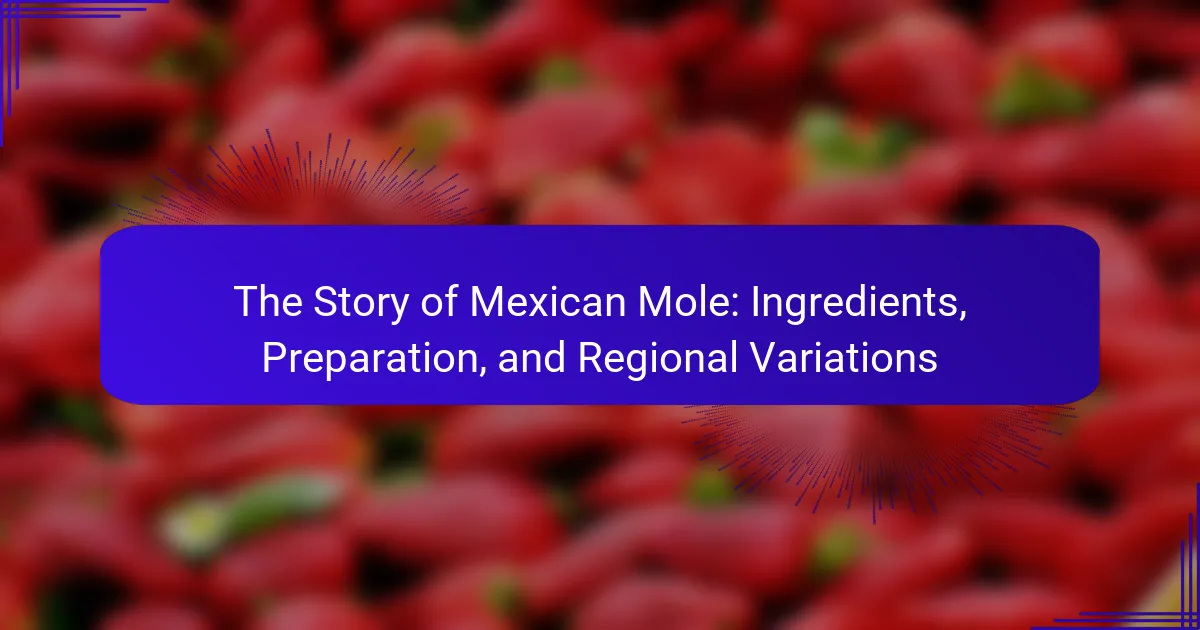
What is Mexican Mole?
Mexican mole is a traditional sauce originating from Mexico, known for its rich and complex flavors. It typically includes ingredients like chili peppers, spices, nuts, and chocolate. Mole can vary significantly by region, with each area having its unique recipe and preparation methods. For example, mole poblano is famous for its use of chocolate, while mole verde features green ingredients like tomatillos and cilantro. The dish is often served over meats, such as chicken or turkey, and is a staple in Mexican cuisine. Mole has historical significance, dating back to pre-Columbian times and evolving through various cultural influences.
How is Mexican Mole traditionally defined?
Mexican mole is traditionally defined as a rich, complex sauce originating from Mexico. It typically combines a variety of ingredients, including chilies, spices, chocolate, and nuts. Mole is often served over meats or used in various dishes. The preparation involves toasting and grinding ingredients to create a smooth, flavorful blend. Different regions in Mexico have their own unique versions of mole, such as mole poblano and mole negro. Historically, mole has roots in pre-Hispanic cuisine, evolving through the influence of Spanish colonization. This cultural fusion contributes to its diverse flavor profiles and variations.
What are the key characteristics of Mexican Mole?
Mexican mole is a rich and complex sauce known for its deep flavors. It typically contains a blend of ingredients including chili peppers, spices, chocolate, and nuts. The sauce can vary significantly by region, with each area having its own unique recipe. Mole has a thick consistency, often achieved by grinding ingredients into a paste. The preparation usually involves toasting and blending various components to enhance flavor. Mole is traditionally served over meats, such as chicken or turkey. It is often accompanied by rice or tortillas. The dish is a staple in Mexican cuisine, celebrated for its cultural significance and culinary diversity.
What role does Mexican Mole play in Mexican cuisine?
Mexican Mole is a fundamental sauce in Mexican cuisine. It serves as a rich, complex flavor enhancer for various dishes. Mole is often used in traditional recipes, such as mole poblano, which combines chocolate with spices. This sauce showcases regional variations across Mexico, highlighting local ingredients and cooking techniques. Mole is integral to celebrations and cultural events, symbolizing heritage and community. Its preparation can involve numerous ingredients, including chiles, nuts, and fruits. The versatility of mole allows it to complement meats, vegetables, and even tamales. Overall, mole is a culinary staple that embodies the diversity and richness of Mexican gastronomy.
What are the essential ingredients of Mexican Mole?
The essential ingredients of Mexican mole include chili peppers, chocolate, nuts, and spices. Chili peppers provide heat and depth of flavor. Common varieties used are ancho, pasilla, and chipotle. Chocolate adds richness and a slight sweetness. Nuts, such as almonds or peanuts, contribute creaminess and texture. Spices like cinnamon, cumin, and cloves enhance complexity. Additionally, tomatoes and onions are often included for a base. Each mole recipe may vary, reflecting regional differences and personal preferences.
What types of chiles are commonly used in Mexican Mole?
Common types of chiles used in Mexican mole include ancho, pasilla, guajillo, and chipotle. Ancho chiles are dried poblano peppers, known for their sweet and smoky flavor. Pasilla chiles are dark and have a rich, complex taste. Guajillo chiles are bright red and offer a mild heat with berry-like notes. Chipotle chiles are smoked jalapeños, adding a distinct smoky spiciness. These chiles contribute to the depth and complexity of mole sauces, which vary across regions in Mexico.
How do spices and herbs contribute to the flavor of Mexican Mole?
Spices and herbs are essential to the flavor profile of Mexican mole. They provide depth, complexity, and balance to the sauce. Common spices include cumin, which adds warmth, and cinnamon, which introduces sweetness. Herbs like oregano contribute an earthy note. Each spice and herb interacts with the chocolate base, enhancing its richness. The combination of these ingredients creates a harmonious blend of flavors. Traditional recipes often vary by region, showcasing local spices and herbs. This regional diversity influences the overall taste of mole.
What other ingredients are typically included in Mexican Mole recipes?
Mexican mole recipes typically include a variety of ingredients. Commonly used items are dried chilies, such as ancho and guajillo. Nuts, particularly almonds and peanuts, are also essential in many mole recipes. Seeds, like sesame seeds, contribute to the flavor and texture. Additionally, spices such as cinnamon and cloves are frequently included. Chocolate, often dark or unsweetened, adds depth to the sauce. Fruits like tomatoes and plantains can also be present in some variations. Finally, broth or water is used to achieve the desired consistency. These ingredients combine to create the complex and rich flavors characteristic of mole.
How is Mexican Mole prepared?
Mexican mole is prepared by combining various ingredients to create a rich sauce. The process typically begins with toasting dried chiles to enhance their flavor. Common chiles used include ancho, pasilla, and guajillo. Next, the toasted chiles are blended with other ingredients like tomatoes, garlic, and spices. Nuts, such as almonds or peanuts, are often added for texture. The mixture is then simmered to meld the flavors. Finally, mole can be served over meats or alongside rice. This preparation method varies by region, reflecting local ingredients and traditions.
What are the steps involved in making traditional Mexican Mole?
To make traditional Mexican Mole, begin by toasting dried chilies. Remove seeds and stems from the chilies. Next, soak the chilies in hot water until soft. Blend the soaked chilies with garlic, onion, and spices to form a paste. Heat oil in a pan and sauté the paste until fragrant. Gradually add broth and simmer the mixture. Incorporate chocolate and other ingredients like nuts or seeds as desired. Finally, cook until the mole thickens and flavors meld. Traditional mole often involves regional variations in ingredients and preparation techniques.
How does the cooking technique influence the final flavor of Mexican Mole?
The cooking technique significantly influences the final flavor of Mexican mole. Different methods such as roasting, frying, or simmering impact the depth and complexity of flavors. Roasting ingredients like chilies and spices enhances their natural sweetness and smokiness. Frying can add richness and a toasty flavor profile. Simmering allows the ingredients to meld, creating a harmonious taste. Furthermore, the duration of cooking affects flavor development; longer cooking times can intensify the overall taste. Each technique contributes unique characteristics, making the mole distinct in flavor based on preparation.

What are the regional variations of Mexican Mole?
Mexican mole has several regional variations, each with distinct ingredients and preparation methods. Mole Poblano is the most famous, originating from Puebla. It features chocolate, chili peppers, and spices. Mole Negro is a rich, dark sauce from Oaxaca, known for its complex flavor profile. Mole Verde is a green mole also from Oaxaca, made with tomatillos and green herbs. Mole Rojo, another Oaxacan variant, includes red chilies and tomatoes. Each region adds unique local ingredients, reflecting cultural influences and traditions. These variations highlight the diversity of Mexican cuisine and its regional identities.
How do different regions in Mexico influence the preparation of Mole?
Different regions in Mexico significantly influence the preparation of Mole. Each region utilizes distinct local ingredients and cooking techniques. For example, Oaxacan Mole is known for its complex flavors and use of chocolate. In contrast, Puebla’s Mole Poblano features a sweeter profile with the inclusion of almonds and raisins. The Yucatán region incorporates spices like achiote, giving its Mole a unique color and taste. Regional variations also reflect cultural heritage and historical influences, showcasing indigenous and colonial culinary practices. The diversity in preparation methods and ingredients highlights Mexico’s rich culinary landscape.
What are the distinct characteristics of Oaxacan Mole?
Oaxacan Mole is known for its rich complexity and unique flavor profile. It typically contains a blend of various chiles, such as ancho, pasilla, and chipotle. This mole often includes ingredients like chocolate, nuts, and spices, contributing to its depth. The preparation involves a labor-intensive process of toasting and grinding ingredients. Oaxacan Mole is traditionally served with meats, particularly chicken or turkey. Its distinctiveness comes from regional variations and local ingredients. The use of indigenous techniques and flavors enhances its authenticity. Oaxacan Mole is recognized as a UNESCO Intangible Cultural Heritage of Humanity, highlighting its cultural significance.
How does Poblano Mole differ from other types of Mole?
Poblano Mole is distinct from other types of Mole primarily due to its use of Poblano peppers. These peppers provide a unique flavor profile that is both rich and slightly smoky. In contrast, other moles may use different types of peppers, such as Ancho or Chipotle, which can alter the taste significantly. Poblano Mole typically features a blend of spices and ingredients, including nuts and chocolate, but the Poblano is the defining characteristic. This specific pepper is known for its mild heat and deep, earthy flavor, setting it apart from spicier moles. The preparation method may also differ, with Poblano Mole often being less complex than others, focusing on the pepper’s natural flavors.
What are the cultural significances of regional Mole variations?
Regional Mole variations hold significant cultural importance in Mexico. Each variation reflects the unique history and traditions of its region. For instance, Oaxacan Mole is known for its complexity and use of local ingredients. This variation showcases indigenous culinary practices and regional biodiversity. In Puebla, Mole Poblano symbolizes the fusion of Spanish and indigenous cultures. Its creation is tied to historical events, such as the Battle of Puebla. Regional differences in Mole also highlight local agricultural practices and seasonal ingredients. Festivals often celebrate these variations, reinforcing community identity and heritage. Thus, Mole serves as a culinary representation of Mexico’s diverse cultural landscape.
How do celebrations and festivals incorporate Mole in different regions?
Celebrations and festivals incorporate Mole in various regions as a traditional dish that symbolizes cultural heritage. In Oaxaca, Mole is a centerpiece during the Guelaguetza festival, showcasing its rich flavors. In Puebla, Mole Poblano is served during Cinco de Mayo celebrations, honoring historical significance. Festivals often feature Mole in communal meals, emphasizing community and family bonds. Specific ingredients vary regionally, reflecting local produce and traditions. The preparation of Mole is often a communal activity, bringing people together. This culinary practice reinforces regional identity and pride. Events like weddings and religious ceremonies frequently highlight Mole, adding to its cultural importance.
What stories or traditions are associated with regional Mole recipes?
Regional Mole recipes are deeply intertwined with cultural stories and traditions. Each region in Mexico has its own unique version of Mole, reflecting local ingredients and customs. For example, Mole Poblano from Puebla is often associated with celebrations and special occasions. It is said that it was created by nuns in the 17th century to honor a visiting archbishop. Similarly, Oaxacan Mole has seven distinct varieties, each representing different aspects of Oaxacan culture and history. The preparation of Mole often involves communal cooking, where families gather to share recipes and stories. These traditions highlight the importance of Mole in Mexican heritage, symbolizing unity and celebration.

What are some tips for making the best Mexican Mole at home?
Use high-quality ingredients for the best Mexican mole. Authentic mole includes various chiles, spices, and chocolate. Toast the chiles and spices to enhance their flavors. A blend of different chiles adds depth and complexity. Incorporate nuts and seeds for richness and texture. Simmer the mole slowly to develop its flavors fully. Adjust sweetness with sugar or chocolate to balance the heat. Finally, allow the mole to rest before serving to improve the taste.
What common mistakes should be avoided when preparing Mexican Mole?
Using too many ingredients can overwhelm the flavor of Mexican mole. Mole is traditionally complex but should maintain a balance. Overcooking the sauce often results in bitterness. Mole requires careful simmering to develop flavors without burning. Skipping the toasting of spices leads to a flat taste. Properly toasting enhances the depth of flavor. Not blending the sauce thoroughly can leave a gritty texture. A smooth consistency is essential for the best mouthfeel. Adding salt too early can cause over-salting during cooking. Salt should be adjusted at the end for precision. Finally, neglecting to taste throughout the process can result in an unbalanced dish. Continuous tasting allows for adjustments to achieve the desired flavor profile.
How can adjustments be made for personal taste preferences in Mole?
Adjustments for personal taste preferences in Mole can be made by altering the ingredient proportions. For example, increasing the amount of chocolate can enhance sweetness. Reducing chili peppers will decrease spiciness. Adding more nuts can create a creamier texture. Incorporating different spices can introduce unique flavors. Substituting ingredients, like using different types of chili, can also adjust the heat level. Experimenting with acidity, such as adding lime juice, can balance flavors. Each adjustment allows for a personalized Mole experience. These modifications are common in regional variations of Mole across Mexico.
What tools and equipment are helpful in making Mexican Mole?
A variety of tools and equipment are helpful in making Mexican mole. Essential items include a heavy skillet or comal for toasting ingredients. A blender or food processor is needed for achieving a smooth sauce consistency. A large pot is required for simmering the mole with the broth and other ingredients. A mortar and pestle can be used for grinding spices and nuts. Measuring cups and spoons ensure accurate ingredient amounts. A wooden spoon is useful for stirring the sauce during cooking. These tools facilitate the preparation process and enhance the flavor of the mole.
Mexican mole is a traditional sauce known for its rich and complex flavors, made primarily from ingredients such as chili peppers, spices, nuts, and chocolate. The article delves into the definition, essential ingredients, preparation methods, and regional variations of mole, highlighting its cultural significance in Mexican cuisine. Key types of mole, including mole poblano and mole oaxaqueño, are explored, along with the influence of local ingredients and cooking techniques. Additionally, the article offers tips for making mole at home and common mistakes to avoid, ensuring a comprehensive understanding of this culinary staple.
